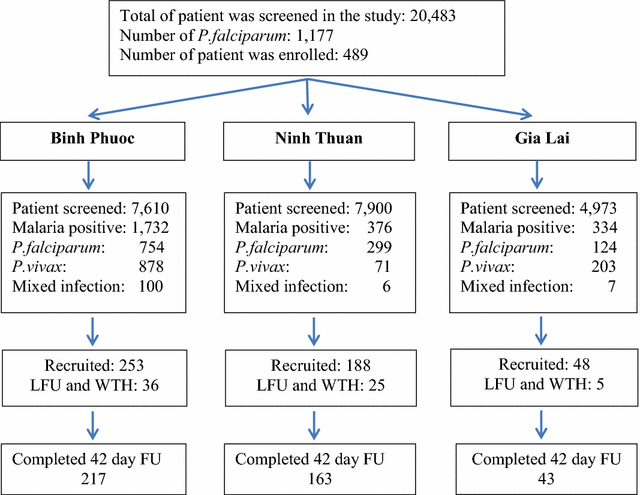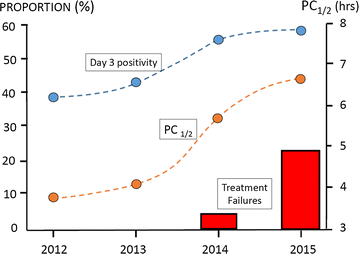Rapid decline in the susceptibility of Plasmodium falciparum to dihydroartemisinin-piperaquine in the south of Vietnam
- PMID: 28086775
- PMCID: PMC5237149
- DOI: 10.1186/s12936-017-1680-8
Rapid decline in the susceptibility of Plasmodium falciparum to dihydroartemisinin-piperaquine in the south of Vietnam
Abstract
Background: Artemisinin resistant Plasmodium falciparum has emerged in the countries of the Greater Mekong sub-region posing a serious threat to global malaria elimination efforts. The relationship of artemisinin resistance to treatment failure has been unclear.
Methods: In annual studies conducted in three malaria endemic provinces in the south of Vietnam (Binh Phuoc, Ninh Thuan and Gia Lai) between 2011 and 2015, 489 patients with uncomplicated P. falciparum malaria were enrolled in detailed clinical, parasitological and molecular therapeutic response assessments with 42 days follow up. Patients received the national recommended first-line treatment dihydroartemisinin-piperaquine for three days.
Results: Over the 5 years the proportion of patients with detectable parasitaemia on day 3 rose steadily from 38 to 57% (P < 0.001). In Binh Phuoc province, the parasite clearance half-life increased from 3.75 h in 2011 to 6.60 h in 2015 (P < 0.001), while treatment failures rose from 0% in 2012 and 2013, to 7% in 2014 and 26% in 2015 (P < 0.001). Recrudescence was associated with in vitro evidence of artemisinin and piperaquine resistance. In the treatment failures cases of 2015, all 14 parasite isolates carried the C580Y Pfkelch 13 gene, marker of artemisinin resistance and 93% (13/14) of them carried exoE415G mutations, markers of piperaquine resistance.
Conclusions: In the south of Vietnam recent emergence of piperaquine resistant P. falciparum strains has accelerated the reduced response to artemisinin and has led to treatment failure rates of up to 26% to dihydroartemisinin-piperaquine, Vietnam's current first-line ACT. Alternative treatments are urgently needed.
Keywords: Artemisinin resistance; Parasite clearance half-life; Piperaquine resistance.
Figures





References
-
- National Institute of Malariology Parasitology and Entomology. Report of National institute of malariology parasitology and entomology, 2015.
-
- WHO. World malaria report 2014. Geneva: World Health Organization; 2014.
-
- WHO. Global plan for artemisinin resistance containment. Geneva: World Health Organization; 2011.
-
- WHO. Methods for surveillance of antimalarial drug efficacy. Geneva: World Health Organization; 2009.
MeSH terms
Substances
Grants and funding
LinkOut - more resources
Full Text Sources
Other Literature Sources

